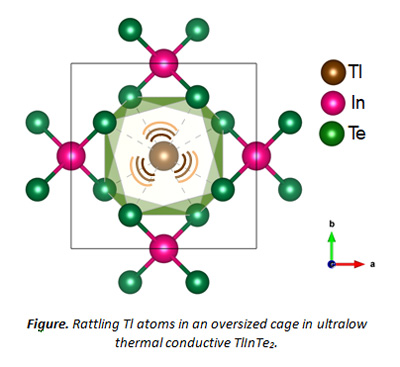 Scientists have identified a major clue to design novel advanced materials with ultralow thermal conductivity that can be used for thermoelectrics, as well as thermal energy management.
Scientists have identified a major clue to design novel advanced materials with ultralow thermal conductivity that can be used for thermoelectrics, as well as thermal energy management.
In semiconducting crystalline solids, heat mainly propagates through vibration of the atomic lattice technically called phonons. Nature of heat flow with the help of phonons need to be understood for developing new materials with low thermal conductivity and this in turn requires a complete structural understanding of the material.
Kanishka Biswas and his group from Jawaharlal Nehru Centre for Advanced Scientific Research (JNCASR), Bangalore, an autonomous institution of the Department of Science and Technology (DST) has made a significant leap forward in understanding the nature of heat flow through the semiconducting compound TlInTe2. They have moved towards unearthing the prime suspects which minimizes the thermal transport in this material which could serve as clues to design novel advanced thermal conductive materials.
In their recent study published in Angewandte Chemie, they have performed two experiments to uncover the origin of ultra-low thermal conductivity in TlInTe2. These experiments are called temperature dependent Synchrotron X-ray Pair Distribution Function (PDF) and Inelastic Neutron Scattering (INS) experiments.
Through their analysis they found evidence of structural features that disrupt the conduction of heat. These features are rattling vibration of Tl inside a rigid covalent framework and presence of significant chemical bonding hierarchy. They observed that the compound TlInTe2 seems to embody two contrasting lattice frameworks (covalent and ionic) into one. This essentially allows a smooth electrical transportation, while simultaneously restricting the heat flow.
According to the Prof. Kanishka Biswas fundamental understanding of the correlation between chemical bonding and lattice dynamics is extremely important to discover new low thermal conductive solids, which is possible here because of the access to the excellent Synchrotron and Neutron beam line facilities through the support of DST Synchrotron and Neutron program.
The research team believes that this work would serve as a major indicator to uncover and anticipate novel advanced materials with desired ultralow thermal conductivity such that it can be used for applications like thermoelectrics, thermal barrier coating, thermal energy management etc.
Publication link: https://doi.org/10.1002/anie.202013923
For more details Kanishka Biswas (biswas[dot]kanishka[at]gmail[dot]com) can be contacted.






























